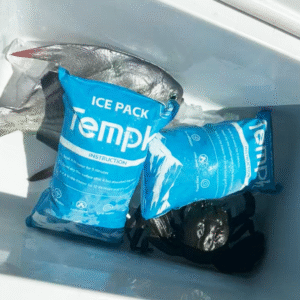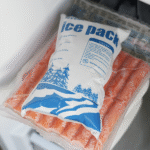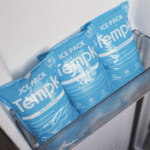How Do Dry Ice Packs Improve Fish Shipping and Cold Chain Logistics?
Shipping seafood requires precise management to maintain quality and ensure the product reaches consumers at its freshest state. Dry ice packs have become a critical component in fish shipping, as they help preserve temperature-sensitive products by providing a reliable, efficient cooling solution. In this article, we explore the vital role that dry ice packs play in the cold chain logistics of seafood, highlighting their benefits, how they maintain cold temperatures during transit, and best practices for their use.

-
What are dry ice packs for fish shipping and how do they work?
-
How do dry ice packs maintain cold temperatures during transit?
-
What are the benefits of using dry ice in seafood cold chain logistics?
-
How can businesses implement dry ice packs effectively for fish shipping?
What Are Dry Ice Packs for Fish Shipping and How Do They Work?
Dry ice packs are a form of solid carbon dioxide that sublimate directly from a solid state to a gas, creating an intensely cold environment. These packs are crucial for shipping temperature-sensitive goods, such as fish, to maintain the required low temperatures during transit. Sublimating at a temperature of -78.5°C (-109.3°F), dry ice ensures that seafood remains frozen, preserving freshness and preventing spoilage.
As dry ice sublimates, it absorbs heat from its surroundings, cooling the enclosed space, which helps maintain the desired temperature for longer durations. This process makes dry ice an excellent choice for seafood shipments, especially for long-distance or overnight deliveries.
How Do Dry Ice Packs Maintain Cold Temperatures During Transit?
The key function of dry ice packs during transit is to keep the temperature consistently low. As the dry ice sublimates, it creates a cold gas that absorbs heat from the environment inside the shipping container. Research has shown that using dry ice can lower the temperature by up to 30°F (16.7°C), which is essential for maintaining the quality of seafood.
By placing dry ice strategically within insulated containers, shippers can keep seafood at the desired temperature throughout the shipping process. This is particularly critical when shipping seafood over extended distances or in warmer climates.
Temperature Control Methods:
| Method | Timeframe | Effectiveness | Practical Application |
|---|---|---|---|
| Dry Ice | 24-48 hrs | Highly Effective | Ideal for overnight seafood shipping |
| Gel Packs | Varies | Moderate | Suitable for short shipments |
| Ice Packs | Varies | Low to Moderate | Best for sturdier seafood types |
Dry Ice Packs in Action: Real-Life Examples
For example, a seafood distributor shipping fresh salmon across the U.S. can rely on dry ice to ensure that the fish stays frozen throughout the journey, arriving at the destination in prime condition. Similarly, during peak demand periods, a restaurant supplier can use dry ice to keep live shellfish alive and fresh during transport.
A case study from a Seattle-based seafood supplier shows that by transitioning to dry ice packs, they experienced a 15% increase in customer satisfaction due to enhanced product quality upon delivery.
What Are the Benefits of Using Dry Ice in Seafood Cold Chain Logistics?
Dry ice offers several advantages for the seafood cold chain logistics process, making it an ideal solution for shipping fish and other temperature-sensitive products.
Key Benefits:
-
Extended Shelf Life: Dry ice helps keep seafood frozen for up to 48 hours, providing more flexibility in shipping durations without compromising quality.
-
Cost Efficiency: By reducing spoilage and waste, dry ice packs minimize operational costs and help businesses save on product loss, contributing to overall profitability.
-
Non-toxic and Safe: Unlike other refrigerants, dry ice is non-toxic and safe when handled properly. Its use eliminates the need for potentially hazardous chemicals in the shipping process.
-
Sustainability: Dry ice is produced from recycled CO₂, making it an environmentally friendly option compared to other cooling methods.
Additional Advantages
-
Prevents Bacterial Growth: Keeping seafood at the right temperature during shipping ensures that bacteria cannot thrive, preserving the quality of the fish.
-
Prevents Freezer Burn: By controlling the temperature and preventing excess moisture, dry ice helps avoid freezer burn, maintaining the fish’s texture and taste.
FAQs About Using Dry Ice in Seafood Shipping
Q: How long can dry ice keep seafood frozen?
A: Dry ice can keep seafood frozen for 24-48 hours, depending on the quantity used and the conditions during transit.
Q: Are there any regulations for shipping seafood with dry ice?
A: Yes, shipments using dry ice must adhere to the Department of Transportation’s (DOT) regulations on packaging and labeling.
Trends and Developments for 2025 in Cold Chain Logistics
The cold chain logistics industry is rapidly advancing, with a growing emphasis on sustainability and technological innovation. In 2025, companies are likely to focus on eco-friendly dry ice production methods and improved real-time tracking for sensitive shipments through IoT technology.
Latest Developments in Dry Ice Technology
-
Sustainable Production: Manufacturers are working on developing more sustainable dry ice production methods to reduce carbon footprints.
-
IoT Integration: Real-time temperature monitoring using IoT technology will become more widespread, ensuring accurate tracking of sensitive shipments.
Market Insights
The seafood industry is experiencing increasing demand for fresh and sustainably sourced products. Companies that adopt efficient cold chain logistics solutions, such as dry ice, will be better equipped to meet this demand and maintain high product quality during transit.
Common Questions Answered
Q1: What types of companies benefit from using dry ice for shipping seafood?
A: Seafood wholesalers, retailers, and restaurants benefit from using dry ice to keep seafood fresh during transport.
Q2: Is it safe to handle dry ice?
A: Dry ice is safe to handle when proper precautions are taken. It should be handled with gloves, and care should be taken to ensure it is not enclosed in airtight spaces.
Conclusion and Recommendations
In conclusion, dry ice packs are an essential tool in cold chain logistics, particularly in the seafood industry. They ensure that seafood products arrive fresh and undamaged by maintaining optimal temperatures throughout the transit process. By integrating dry ice into your logistics operations, you can significantly improve product quality and reduce costs.
Next Steps
Businesses in the seafood industry should consider incorporating dry ice into their cold chain solutions. Begin by training staff on safe handling procedures, upgrading shipping containers, and using real-time temperature monitoring to track shipments.
About Tempk
At Tempk, we specialize in innovative cold chain solutions for the seafood industry. Our packaging systems are designed to keep products fresh while promoting sustainability. Contact us today to learn more about how our dry ice solutions can optimize your logistics operations!























